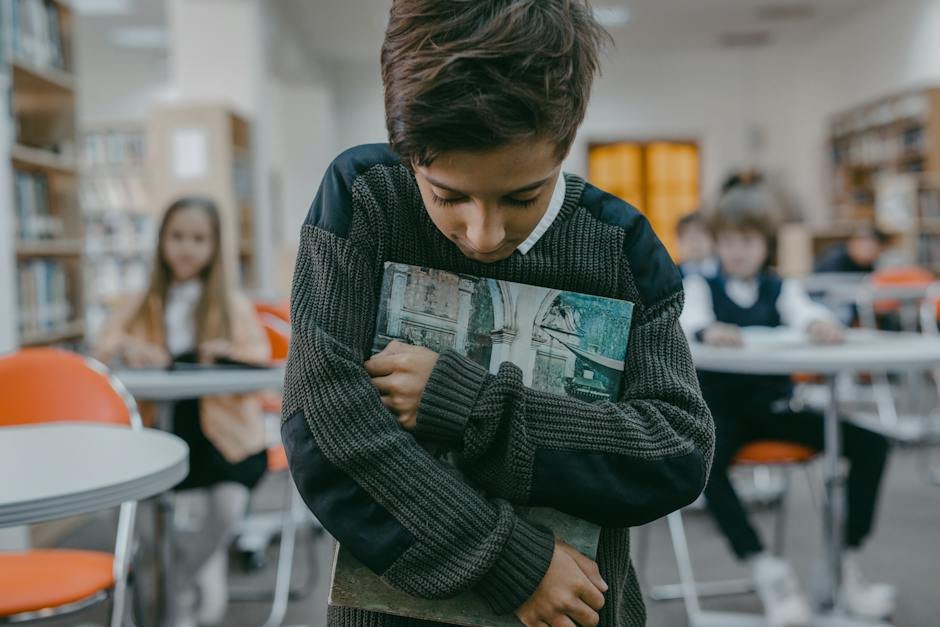
Navigating the complex world of social interaction poses a unique set of challenges for children on the autism spectrum. With brains wired distinctly, they perceive and interact with their environment differently from their neurotypical peers, often leaving them exposed to misunderstandings and, unfortunately, bullying. While their journey may be paved with unconventional beauty, it also undeniably invites vulnerabilities. This essay endeavors to shed light on these children’s experiences, unraveling how their distinctive way of interpreting the world intensifies their susceptibility to bullying, and more vitally, how we as a community can uplift and defend them.
Understanding Autism and Vulnerability to Bullying
Understanding the Vulnerability of Children with Autism to Bullying
When it comes to our children, every parent hopes to foster an environment that is safe, nurturing, and inclusive. However, it is a disheartening reality that children with autism spectrum disorder (ASD) are more susceptible to bullying than their neurotypical peers. By exploring the reasons behind this vulnerability, the community can come together to provide better protection and advocacy for these children.
Children with autism perceive the world differently; their unique processing can affect social communication and interaction, which are key areas that bullies often exploit. Since understanding social cues and body language isn’t always intuitive for kids with ASD, bullies might see them as easy targets, as they may not readily identify a threat or know how to seek help.
Expressive and receptive language challenges are another hurdle. Children with autism may struggle to articulate their experiences, making it difficult for parents and educators to discern when they are being bullied. Hence, the usual signs of bullying can remain hidden, prolonging the child’s exposure to harm.
Moreover, these kiddos often have distinct interests or behaviors, which, although should be celebrated, can unfortunately set them apart from their peers. Bullies might zero in on these differences, leading to teasing or exclusion. While children typically strive for acceptance within their peer groups, those with ASD may have a harder time fitting in, inadvertently increasing their risk of being bullied.
One of the subtler reasons is the difficulty in making and maintaining friendships. Many children with autism want to connect with others but may not know how. This can lead to social isolation, making them appear as lone targets to bullies and depriving them of peer support that can discourage bullying behavior.
The key to changing this bullying narrative is multi-faceted. It involves empowering children with autism with social skills through tailor-made programs, spreading awareness about ASD in schools to foster an environment of inclusion and respect, and equipping educators and parents with the tools to recognize and intervene effectively when bullying occurs.
Creating a safe space for children with autism isn’t just important – it’s imperative. Through understanding, empathy, and action, a more protective and accepting environment can be cultivated, ensuring that every child, regardless of their abilities, has the chance to thrive unhampered by the threat of bullying. Let’s unite to turn the tide against bullying and champion for the wellbeing of our children with autism. Together, a difference can be made—one that upholds the right of every child to feel safe, valued, and accepted in their community.

Recognizing Signs of Bullying in Children with Autism
Spotting the Signs: How to Know If Your Child with Autism Is Being Bullied
Oh, the joys and trials of parenthood, right? We all wish our homes could be a haven of peace and safety for our little ones, but when they step out into the wider world—especially school—it’s like sending a piece of our heart out into the wild. It can be even more nerve-racking for parents of children with autism, knowing that our tykes might face unique challenges. One particular concern that keeps cropping up is the risk of bullying.
It’s important to recognize the signs of bullying, because kiddos with autism may not always tell us directly. They might have a hard time explaining their feelings, or they might not even understand that what’s happening to them is bullying. We need to be their advocates, their eyes, and ears, but how?
Here’s a little beacon of guidance—a rundown of signs that can indicate that a child with autism is encountering a bully on the playground or in the classroom.
- Unexplained Physical Marks: If there are consistent signs of physical harm like scratches, bruises, or torn clothing, it’s a clear red flag. Understandably, kids get into scuffles or have accidents, but when there’s a pattern, it’s time to dig deeper.
- Sudden Change in Behaviour or Mood: If a child who once hopped off the school bus with a smile is now withdrawing, showing signs of depression, or displaying outbursts of anger, something is off. Bullying can be a significant trigger for mood alterations and changes in demeanor.
- Reluctance to Go to School: When the morning routine turns into a daily battle with a child who was previously okay with school, take note. This could be a child’s non-verbal way of saying they feel unsafe or scared at school.
- Regression in Developmental Progress: Huge strides in development could begin to backslide, including in areas such as toilet training, speech, or self-care. It’s like they’re taking a few steps back at a time when they should be proudly marching forward.
- Changes in Eating Habits: Whether it’s coming home with an untouched lunch box because someone ruined their appetite, or raiding the pantry due to stress-eating, a change in eating behavior can signal distress.
- Possessions Going Missing: Regularly missing toys, school supplies, or even money might indicate that a child is being coerced or bullied into giving up their belongings.
- Sleep Disruption: Nightmares, difficulty falling asleep, or frequent awakenings could be signs that anxiety from daytime bullying is spilling into the night.
- Dropping Grades or School Performance: It’s hard for any kiddo to focus on academics when they’re worried about a bully. If grades slide without explanation, it’s time to check if bullying is the culprit.
Being alert to these signals is crucial, as they often serve as the breadcrumbs leading to the bigger issue. It takes a village to raise a child, as the saying goes, and it’s no different when it comes to safeguarding our children with autism from the harsh realities of bullying. Stay attuned, stay vigilant, and remember, creating a dialogue with teachers, school staff, and, most importantly, your child, can make a world of difference. Let’s keep those lines of communication open and ensure every child feels safe and valued, both in and out of our nests.

Strategies for Preventing and Addressing Bullying
Heading into further detail, it’s crucial to address and prevent bullying of children with autism by recognizing potential signs and implementing tailored strategies beyond awareness. Watching for changes that could indicate a child is experiencing bullying is a supportive starting point. Parents and educators should stay vigilant for signs such as:
- Unexplained physical marks or injuries that cannot be accounted for.
- A sudden change in behavior or mood, such as increased agitation, depression, or anxiety which are out of character for the child.
- A strong reluctance to go to school or participate in activities where bullying might have occurred.
- Noticeable regression in developmental progress or loss of acquired skills, which could signal distress.
- Distinct changes in eating habits, whether that be a loss of appetite or, conversely, overeating, particularly when these changes correlate with school days or certain social activities.
- Another sign to be aware of is possessions going missing or being damaged, as this could indicate that a child is being targeted by peers.
- Sleep disruptions, including difficulty falling or staying asleep, can also be signs of stress and should be monitored.
- Lastly, a sudden drop in grades or overall school performance might suggest a child with autism is struggling with more than just academics.
Beyond keeping an eye out for these signs, there are strategies and practical steps that families and schools can take to actively prevent and address the bullying of children with autism:
- Self-Advocacy Skills: Teaching children with autism to speak up for themselves is essential. Use role-playing exercises to practice scenarios where they might need to assertively communicate their need for help.
- Buddy Systems: Pair up children with autism with peers who can be their buddy in social situations, helping to foster friendships and minimize isolation.
- Regular Check-Ins: Establish a routine of checking in with the child about their day, encouraging open dialogue. Sometimes children with autism may communicate distress through patterns or drawings, so it’s important to pay attention to non-verbal cues as well.
- Safe Zones: Create designated ‘safe zones’ at school where children can go if they feel overwhelmed or threatened. Staff should be trained to spot children who may need to use these zones.
- Specific Policies and Protocols: Schools should implement clear, specific anti-bullying policies that include steps for intervention and protocols for when a child with autism is bullied. These should be communicated to all students, staff, and parents.
- Peer Education: Conduct classroom sessions where students learn about diversity and the importance of accepting others. Encourage students to celebrate differences, fostering a culture of inclusion.
- Empowering Witnesses: Often, children witness bullying but don’t know what to do. Teach bystander intervention techniques so peers can play a role in stopping bullying.
- Therapeutic Support: Some children may benefit from counseling services if bullying experiences have led to trauma or severe anxiety, helping to process their experiences in a safe environment.
- Inclusive Extracurricular Activities: Encourage and create extracurricular activities that are inclusive to children with different abilities, which can foster a sense of belonging and community.
- Open Communication With School Staff: Ensure there is open and ongoing communication between parents and school staff. This collaboration is key to monitoring behavior and intervening when necessary.
By proactively addressing these areas and staying connected as a community, a substantial positive impact can be made to protect and empower children with autism against the challenges of bullying. The goal is to create a nurturing environment where all children, regardless of their abilities, can learn, grow, and thrive without fear of intimidation or aggression.

Support Systems and Resources for Families
Navigating the Rough Seas: Support Systems for Families Facing Bullying
When the ship of family sails into the choppy waters of bullying, it can feel like an overwhelming storm to weather. Especially for families with children on the autism spectrum, who may already face daily challenges, bullying can be not just a hurdle but a mountain to climb. But take heart, dear families, you’re not alone on this voyage. There are support systems and resources galore that stand ready to offer aid and comfort.
For starters, let’s talk about seeking allies in the educational system. The importance of an engaged and informed school team cannot be overstated. School counselors and psychologists are trained professionals who can provide a net of emotional and psychological support. They can help craft Individualized Education Programs (IEPs) that include anti-bullying goals and safety plans tailored to each child’s unique needs.
And let’s not forget legal resources. Federal laws, including the Individuals with Disabilities Education Act (IDEA), provide protections that ensure children with disabilities have equal access to education – which includes the right to learn in a bully-free environment. When the going gets tough, sometimes having knowledge about these laws can make all the difference in navigating the bureaucratic waves.
The strength of community cannot be underestimated in these trying times. Online forums and local support groups for parents of children with autism offer a listening ear, shared experiences, and collective wisdom. These sanctuaries of support can act as lifeboats, keeping families afloat as they exchange tips and advice on how to handle bullies.
For additional hands on deck, national organizations such as the Autism Society, PACER’s National Bullying Prevention Center, and StopBullying.gov provide extensive resources, including training materials, webinars, and toolkits. They can help parents become staunch advocates for their children and educate themselves on the most effective strategies for bullying prevention and response.
Some children may benefit from the guidance of a mentor – a trusted adult who understands autism and can serve as a navigator, helping them understand social situations and develop coping strategies. Mentoring programs may be available through local autism advocacy groups or educational institutions.
In the end, building a flotilla of support around a child is vital. Open lines of communication with all hands involved – from teachers to peers to extended family – ensures everyone is part of the crew, working together to steer clear of bullying’s harsh winds.
Remember, while traversing these difficult waters can be daunting, the collective strength of dedicated resources, a supportive community, and empowered families will lead to smoother sailing. Just as a lighthouse provides guidance to ships at sea, these support systems offer the light of hope and direction to families navigating bullying. With these tools and alliances, the journey ahead is one that can be undertaken with confidence and resilience.

Creating a Safe and Nurturing Home Environment
Creating a safe and nurturing home environment is paramount for all children, and it becomes even more crucial when a child has autism. Given the unique challenges these children may face, fostering a space that feels secure and supportive can significantly impact their overall well-being and development.
One of the key elements in establishing this sanctuary is the cultivation of a predictable routine. Consistency offers comfort, helping children with autism understand what to expect next. This predictability can reduce anxiety and enable them to feel more in control. Crafting visual schedules or using apps specifically designed to outline daily activities can make routines more accessible and engaging for children with autism.
Adapting the physical space at home to suit a child’s sensory needs can also be a game-changer. Some children might be hypersensitive to lights, sounds, or textures, while others may be under-sensitive. Taking into consideration these sensory preferences – whether it’s dimming harsh lights, reducing background noise, or creating cozy corners with soft pillows and weighted blankets – can help minimize sensory overload and create a calming retreat where children can unwind and feel safe.
Encouraging a child’s independence within the home is another step toward fostering a secure environment. Simple changes, like organizing the living space so that personal belongings and toys are within easy reach, empower children with autism to do things on their own, instilling confidence and a sense of self-sufficiency.
Moreover, the home should be an inviting place for open communication. It’s important to listen attentively and offer plenty of opportunities for non-verbal communication too. Establish an atmosphere where all feelings are valid and expressible without judgment. Maintaining this dialogue also means that children can share their concerns and triumphs, knowing their voice is heard and valued.
Quality family time plays a crucial role in creating a nurturing environment. Engaging in activities that everyone enjoys, like playing board games, cooking together, or having movie nights, reinforces the bonds between family members. It’s during these shared moments that children with autism can feel a part of something bigger and experience the warmth of family solidarity.
Lastly, encouraging a strong relationship with nature can be immensely beneficial for children with autism. Whether it is tending to a garden, observing birds, or playing outdoors, nature has a calming effect and can serve as a valuable teaching tool.
Every child deserves a place where they feel secure, understood, and nurtured. With the right strategies in place, creating a safe and nurturing home environment for children with autism is not just a goal, but an achievable reality that can provide them with the foundation they need to thrive.

The journey towards embracing differences and nurturing acceptance is ongoing. By diligently crafting a backdrop of understanding, compassion, and proactive intervention both within our homes and society, we create the keystone for safeguarding our children with autism from the shadows of bullying. As we’ve traversed from understanding their world to fortifying their defenses, we recognize that each stride taken is a step toward a more inclusive future. Let our collective efforts resonate as a beacon of hope, illuminating the path to a world where every child, regardless of their neurological makeup, can flourish unencumbered by fear and embraced for who they are.





